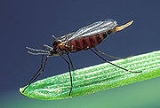
Hessian fly
Encyclopedia
The hessian fly or barley midge, Mayetiola destructor, is a species of fly
that is a significant pest of cereal crops including wheat
, barley
and rye
. Though a native of Asia it was transported into Europe and later into North America, supposedly in the straw bedding of Hessian troops during the American Revolution
(1775–83). There are usually two generations a year but may be up to five. In the spring the dark-coloured female lays about 250 to 300 reddish eggs on plants, usually where the stems are covered by leaves; the larvae feed on the sap and weaken the plants so that they cannot bear grain.
The hessian fly was described by Thomas Say
in 1817. It is a very harmful insect. It mainly attacks the stem, although if it is really hungry it will eat any part of the plant it can find.
In 1836 a severe infestation of Hessian flies resulted in a crop shortage aggravating the financial problems of farmers prior to the Panic of 1837
.
Diptera
Diptera , or true flies, is the order of insects possessing only a single pair of wings on the mesothorax; the metathorax bears a pair of drumstick like structures called the halteres, the remnants of the hind wings. It is a large order, containing an estimated 240,000 species, although under half...
that is a significant pest of cereal crops including wheat
Wheat
Wheat is a cereal grain, originally from the Levant region of the Near East, but now cultivated worldwide. In 2007 world production of wheat was 607 million tons, making it the third most-produced cereal after maize and rice...
, barley
Barley
Barley is a major cereal grain, a member of the grass family. It serves as a major animal fodder, as a base malt for beer and certain distilled beverages, and as a component of various health foods...
and rye
Rye
Rye is a grass grown extensively as a grain and as a forage crop. It is a member of the wheat tribe and is closely related to barley and wheat. Rye grain is used for flour, rye bread, rye beer, some whiskeys, some vodkas, and animal fodder...
. Though a native of Asia it was transported into Europe and later into North America, supposedly in the straw bedding of Hessian troops during the American Revolution
American Revolution
The American Revolution was the political upheaval during the last half of the 18th century in which thirteen colonies in North America joined together to break free from the British Empire, combining to become the United States of America...
(1775–83). There are usually two generations a year but may be up to five. In the spring the dark-coloured female lays about 250 to 300 reddish eggs on plants, usually where the stems are covered by leaves; the larvae feed on the sap and weaken the plants so that they cannot bear grain.
The hessian fly was described by Thomas Say
Thomas Say
Thomas Say was an American naturalist, entomologist, malacologist, herpetologist and carcinologist. A taxonomist, he is often considered to be the father of descriptive entomology in the United States. He described more than 1,000 new species of beetles and over 400 species of insects of other...
in 1817. It is a very harmful insect. It mainly attacks the stem, although if it is really hungry it will eat any part of the plant it can find.
In 1836 a severe infestation of Hessian flies resulted in a crop shortage aggravating the financial problems of farmers prior to the Panic of 1837
Panic of 1837
The Panic of 1837 was a financial crisis or market correction in the United States built on a speculative fever. The end of the Second Bank of the United States had produced a period of runaway inflation, but on May 10, 1837 in New York City, every bank began to accept payment only in specie ,...
.

